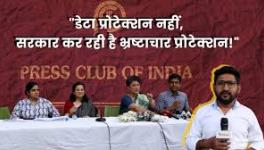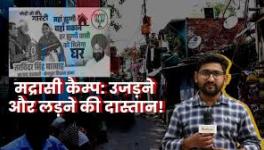March For Our Lives: Glimmer of Hope as Millions Rally For Gun Control

Image Courtesy: NBC News
On Saturday March 24, an estimated 1.2 million people across the United States participated in the “March for Our Lives”, to bring awareness about gun violence in the US and demand the legislative bodies to tighten gun control laws. This movement was triggered by the latest deadly mass-shooting in Parkland, Florida, when a former student killed 17 people at the Marjory Stoneman Douglas High School on February 14, 2018.
Following the massacre, Donald Trump participated in a listening sessionwith the survivors and family members of the killed, where he told them that these events could be avoided if teachers were armed. He reiterated on Twitter this proposal, which is supported by the National Rifle Association, stating: “Armed Educators (and trusted people who work within a school) love our students and will protect them. Very smart people. Must be firearms adept & have annual training. Should get yearly bonus. Shootings will not happen again – a big & very inexpensive deterrent. Up to States.”
This type of reaction by the Washington establishment is no different from the classic “thoughts and prayers” that politicians have been offering after such events, which is followed by half-hearted vows by democrats to push stricter gun control laws, countered by irrational defense of the right to bear arms by republicans on the grounds that such massacres would be avoided if more people had guns. Neither the Sandy Hook Shooting where 28 people – mostly children aged 6 to 7 – were killed at an elementary school, nor the shooting in Las Vegas where 58 people were killed at a country music festival, initiated any meaningful measures for restricting access to firearms.
But this time it was different
The Parkland shooting, however, is seen by many as the tipping point in the gun control debate. On March 14, thousands of students in Parkland and across the nation walked out of their schools for 17 minutes to represent the 17 people who were killed in the Parkland shooting. “It was one of the largest student demonstrations in US history,” the Guardian reported. Moreover, the movement was not restricted to the U.S, but went global. Hundreds of thousands of people poured out on the streets in various cities across the world, holding demonstrations in solidarity with the March for Lives movement and their demands.
Under such enormous pressure, many measures have been initiated by the state to deal with the gun-menace. Two senators in Florida have proposed a “red-flag” bill to “encourage states to adopt legislation allowing law enforcement officials or family members to file gun restraining orders to remove firearms from potentially violent individuals.” Such a law has been reportedly enacted in several states now.
Earlier this month, the U.S Department of Justice, much to the chagrin of the NRA, proposed a ban on bump stock, which is an attachment that allows semi-automatic weapons to fire almost at the rate of a machine gun. The Florida governor passed new gun regulations which included a ban on bump stocks, provoking the NRA – which had donated $30 million to Trump’s presidential campaign – to file a lawsuit. Donald Trump himself was compelled to pass a bill which made provision to improve the national background check system
Beyond gun control: a demand for societal transformation
While the above mentioned victories are important and historic, the demands of students from many schools went beyond the question of what types of weapons should be sold and to whom, and called for striking at the roots of gun-violence in U.S society.
For example, one of the cities most impacted by gun violence is Chicago. It is a city where social services, education, health care are systematically defunded and rendered inaccessible for poor black and brown communities – the very communities under constant surveillance, criminalized, incarcerated and often killed by Law Enforcement. Thus, students from Chicago cannot separate the gun violence in their communities from the institutional violence suffered by their communities that in turn breeds conditions for this violence.
They demanded an end to school closures, an equitable funding for schools in black and brown communities, and called for more school counselors, social workers, access to therapy, a full time nurse, librarians at every school, more after-school programs, reopening of mental health clinics, jobs for youth, for making Chicago a sanctuary city for undocumented immigrants, for ending criminalization of youth by eliminating the gang database (a secret database created by the Chicago Police Department used to identify “gang members”) and taking guns out of schools, and for restorative justice trainings for school staff. Students from black and brown communities in New York City, Philadelphia and other cities had similar demands.
Transcending the liberal gun control discourse
These demands differ substantially from the classic demands of the liberal gun control movement whose focus remain on the question of who can buy the guns and which kind of guns should be sold. This not only fails to strike at the roots of the problem, but also serves to normalize militarization, both at home and abroad, and furthers the use of databases used by law enforcement to criminalize black and brown communities. Unfortunately the central demands of the March for Our Lives Movement fall into this category.
The first demand of the March for Our Lives Movement is to “Pass a law to ban the sale of assault weapons like the ones used in Las Vegas, Orlando, Sutherland Springs, Aurora, Sandy Hook and, most recently, to kill 17 innocent people and injure more than a dozen others at Marjory Stoneman Douglas High School.” This is explained in the statement, “No civilian should be able to access these weapons of war, which should be restricted for use by our military and law enforcement only. These guns have no other purpose than to fire as many bullets as possible and indiscriminately kill anything they are pointed at with terrifying speed” (emphasis added).
Though it does not openly condone the actions of the Law Enforcement and Military, it does not take a critical stance on either them or on their use of arms. In a context when everyday innocent Black people are being murdered by Law Enforcement Officials with impunity and the US Military continues to be involved in several wars and military campaigns overseas in which they have been guilty time and time again of serious human rights abuses and violations of international humanitarian law, it is important to not forget the other victims of violence.
Demand was also made to “close the loophole in our background check law that allows dangerous people who shouldn’t be allowed to purchase firearms to slip through the cracks and buy guns online or at gun shows.” However, this demand did not answer complex questions such as: What methods should the national and local governments use to determine who should and who should not be allowed to buy a gun? Databases like the aforementioned gang database of the Chicago Police Department which supposedly identifies people who are affiliated with or are members of gangs? People are often added to the gang database without being informed just because Police suspect that they are involved in gang-activity and it is almost impossible to be removed, especially when you are unaware you are on the list! Unsurprisingly, of the 128,000 people on the Chicago Gang Database, a large majority of the list (95%) is Black and Latinx. This database has been used tojustify deportations of Latinx people after committing minor infractions and to justify incarceration of Black and Latinx people.
In a situation where most number of perpetrators of such gun-violence have been white men, it is important to take caution to ensure that the measures proposed to fix the problem of gun-violence do not serve as another tool to further criminalize the poor in black and brown communities.
Disclaimer: The views expressed here are the author's personal views, and do not necessarily represent the views of Newsclick.
Get the latest reports & analysis with people's perspective on Protests, movements & deep analytical videos, discussions of the current affairs in your Telegram app. Subscribe to NewsClick's Telegram channel & get Real-Time updates on stories, as they get published on our website.
























